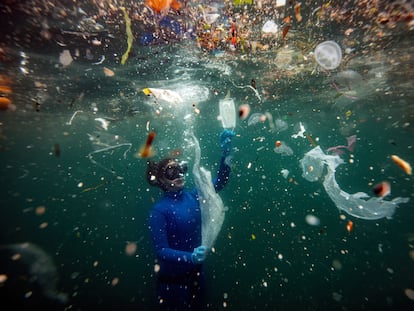Saving the pirarucú, South America’s largest freshwater fish
This ancient species has rebounded in Colombia’s Amazon region thanks to conservation efforts and a greater emphasis on aquaculture
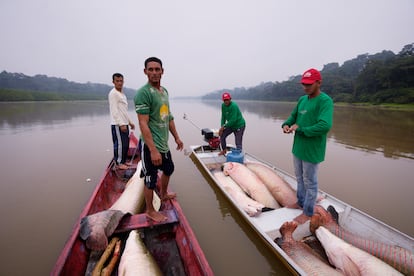
Leticia is the southernmost city of Colombia and the capital of the country’s department of Amazonas. Just a stone’s throw away are the borders with Brazil and Peru. Early one morning in July, the Leticia market was buzzing with fishermen slicing hundreds of fillets from freshly caught pirarucú, the largest freshwater fish in South America. Although fishing for pirarucú is prohibited between October 1 and March 15, it can be found every day of the year on the metal tables of Leticia’s fish market.
The pirarucú is not an ordinary fish. It can grow to almost 10 feet (three meters) in length, and weigh up to 450 pounds (200 kilos), more than a fully-grown pig. Its Portuguese name derives from “red fish” in the indigenous Tupi language, so named because of the bright red edges around the grayish-green scales of sexually mature males.
Unlike the vast majority of fish, this Amazonian giant only spawns about 100 eggs, but most are able to reach adulthood because the male carries the hatchlings around in a sac of milky fluid full of hormones, proteins and other nutrients that he secretes.

The pirarucú has been an essential part of the diet of Amazonian indigenous communities for centuries. Hugo Hernán Franco, a biologist at the University of Amazonia (Colombia) who specializes in Amazonian fish species, says that starting in the late 19th century, the region experienced one boom after another, each one bringing in more and more settlers who decimated pirarucú stocks.
In 1987, the Colombian government banned pirarucú fishing during its six-month reproductive period. “When a male is caught [during spawning season], all the offspring it carries also die, so there is no way for the species to proliferate,” said Franco. “The fishermen now know when and where they breed, so the fry – the young fish – are able to keep on growing”
During fishing season, Colombian regulations ban catching pirarucú smaller than five feet (1.5 meters), which is the typical size of a sexually mature fish. In 2021, Colombia’s aquaculture and fisheries agency (AUNAP) extended the fishing ban, and only allowed the off-season sale of pirarucú imported from certain areas approved by Brazil.
Thirty-five years after the first fishing ban was established, few visitors to the Leticia fish market would think that the pirarucú is endangered. It’s sold everywhere and almost the entire fish can be used. Due to its extensive skeleton, there are only two boneless cuts – loin and breast. Pirarucú loin sells for $1.80 per pound ($4 per kilo) and breast fillets go for $1.35 per pound ($3 per kilo).
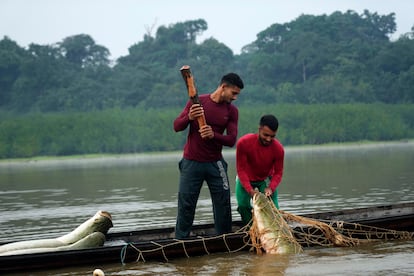
A living fossil
Arapaima gigas is the scientific name of the pirarucú, called paiche in Peru. It is believed to have existed since the Miocene Epoch (23 to 5.3 million years ago), making it one of the oldest fish species. The pirarucú belongs to the Arapaima genus, a word that comes from warapaimo, which in the Macuxi language of northeastern Brazil means “very large fish.” Because of its bony tongue, it belongs to the osteoglossiformes order.
Pirarucú mainly live in the lakes and flooded forestlands surrounding the Amazon River, although it is also found in the Orinoco (Venezuela) and Essequibo (Guyana) river basins. It sits at the top of the food chain in these ecosystems, an agile hunter that goes after anything it can fit in its mouth, from microorganisms to small mammals that fall from trees into the water.
“People say the two largest predators – the pirarucú and the black caiman [Melanosuchus niger] – have a mutual respect,” said Santiago Duque, a professor at the Leticia branch of Colombia’s National University. Duque, who has studied these ecosystems for more than 30 years, says that humans are the only threat to this living fossil. “The caiman doesn’t mess with an adult male pirarucú and the pirarucú doesn’t mess with the caiman.”
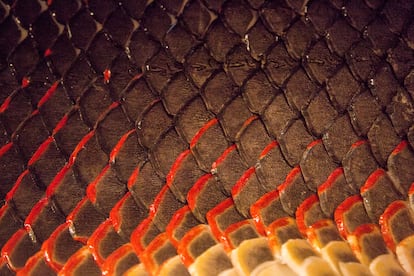
There is no consensus within the scientific community on whether the species is endangered. The International Union for Conservation of Nature (IUCN) places the pirarucú in the “data deficient” category, but has included it since 1975 in Appendix II of the Convention on International Trade in Endangered Species of Wild Fauna and Flora (CITES). This document appendix lists “all species which although not necessarily now threatened with extinction may become so unless trade in specimens of these species is subject to strict regulation in order to avoid utilization incompatible with their survival.”
In 2012, the Red Book of Freshwater Species of Colombia, created by a consortium led by Colombia’s Alexander von Humboldt Biological Resources Research Institute, classified Arapaima gigas as a “vulnerable species”, which is an intermediate threat level on the IUCN scale.
Biologists call the pirarucú an “umbrella species” because it serves as an indicator of the overall health of its ecosystem. Ricardo González, a researcher with the SINCHI Amazonian Scientific Research Institute (Colombia), warns that depletion of the pirarucú's food sources is yet another threat to the species.
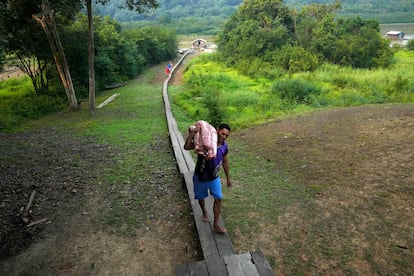
Weak government oversight
Fishermen carry their catches the few hundred feet between Leticia’s port and the market without worrying about prying officials. There are no inspections at Colombia’s border with Tabatinga, its sister city in Brazil, nor at Leticia’s airport. Daniela González and Luz Yolanda Cerón, the only two AUNAP officials in the department of Amazonas, are tasked with inspecting the warehouses of seven authorized fish companies to verify compliance with pirarucú regulations.
None of the pirarucú being sold that July morning bore the seal indicating its legal importation from Brazil, and many were smaller than the legal minimum. But the two inspectors only issued a few warnings that day, and refrained from seizing the product because they lacked law enforcement support. “We need more AUNAP staff, so we don’t have to rely so much on the Navy and security forces,” they said.
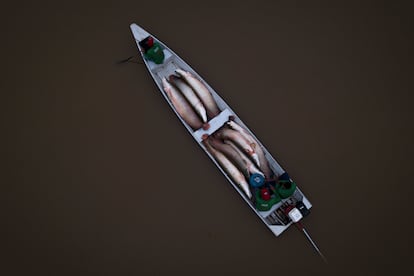
The official pirarucú seal is provided by inspectors from the Mamirauá Institute for Sustainable Development, a Brazilian research center responsible for natural resource management in two Amazon reserves totaling 11,500 square miles (3 million hectares). With main offices in Tefé (Brazil), about 360 miles (587 kilometers) from Leticia, it has become a mainstay of pirarucú conservation, and has collaborated with riverside communities to increase fish stocks by 427% since 1999.
Conservation of a mystical fish
Puerto Nariño is about two hours upriver from Leticia. Huge block letters spelling the name of the city are an ideal site for tourists to take photos with the Amazon River in the background. Right next to it is a giant statue of a pirarucú.
Lilia Java is a representative of the Ticoya indigenous reservation, which includes the area’s main ethnic groups – the Tikuna, Cocama and Yagua. She says that the pirarucú has always been a mystical creature for these peoples. “To us, these are sacred lakes, or fierce lakes, as our ancestors say. The pirarucú live in them and they are the mother of all water.”
As fishing becomes more lucrative, conservation has gotten harder for local communities and the government. A fisherman can sell a pound of pirarucú for about $0.90 ($2 per kilo), so a single adult fish can fetch $200, equivalent to the minimum monthly wage in Colombia.
In the early 2000s, Colombia’s Omacha Foundation reported finding sustained depletion in the number and size of species living in the Tarapoto Lakes, a key wetland region for fish and mammal reproduction. The Ticoya community took heed and banned all pirarucú fishing in the area between 2008 and 2014. They also teamed up with Puerto Nariño to impose catch limits and speed limits for river travel.
Although fishing agreements and conservation are gradually becoming the norm, Java thinks they are inadequate amid all the constant violations. “It’s not just about regulating and monitoring compliance with off-seasons, but about supporting the people who fish for a living while these lakes recover.”
Some communities are looking to ecotourism. In the Wochine nature reserve, which means ceiba tree in the Tikuna language, tourists pay a $2 entrance fee to view the wildlife. But the main attraction is Quintina, a pirarucú who surfaces to swallow mouthfuls of chicken guts tossed in the water by tourists. Java asks rhetorically, “What puts more money in your pocket – a live or dead pirarucú?”
In addition to fishing regulations and ecotourism, SINCHI’s Ricardo González believes that fish farming is the “logical answer” to declining fish stocks. An agency within Colombia’s Environment Ministry, SINCHI has been tasked with conducting feasibility studies for fish farming in the department of Amazonas. “Everyone asks us about the pirarucú, but we still don’t know if it’s viable to farm this species around here,” he said.
Because there are no roads to these remote regions, the feasibility of pirarucú farming depends on the cost and logistics of flying in fish food from distant producers in Peru, Brazil and other parts of Colombia, and then flying live hatchlings to farms around the country. Pirarucú farms in Leticia and Puerto Nariño are still in experimental stages.
Fish farming in Caquetá
Fish farmers around Florencia, the capital of Colombia’s department of Caquetá, seemed to have overcome the obstacles to pirarucú farming. Caquetá has become the center of Colombian pirarucú farming due to a convenient location in the foothills of the eastern mountain range and the roadways connecting it to the rest of the country.
The first live pirarucú was brought to Florencia in the late 1980s by Hugo Hernán Franco’s father, also named Hugo. Now one of the biggest fish farmers in the area, Franco said, “We started from scratch.” He says he had to leave the family’s cattle ranch in the 1970s because of all the violence and instability. He returned in the 1990s after learning how to farm fish from an American businessman named Gregory Nielsen.
Franco brought the first pirarucú fry to Florencia from Leticia by plane, but it took him almost 10 years to get them to reproduce. Today, more than 20 years after the first harvest, his company (Piscícola Pirarucú) sells to exclusive restaurants in Bogotá and Medellín, including renowned chef Leonor Espinosa’s Leo Restaurant.
Piscícola El Rincón is another successful pirarucú farm near Florencia owned by Gustavo Hermida. He and Franco are optimistic about the future of the pirarucú business, but believe that they need to avoid mass markets and instead focus on gradual expansion within their niche market.
This investigation is part of the third edition of the journalistic special ‘Historias en clave verde’, the result of the training ‘CdR/Lab Collaborative journalism to narrate and investigate socio-environmental conflicts’, which was carried out in the Amazon by the Editorial Board (CdR ), thanks to the support of the Deutsche Welle Akademie (DW) and the German Cooperation Agency, as part of the Ríos Voladores alliance.
Tu suscripción se está usando en otro dispositivo
¿Quieres añadir otro usuario a tu suscripción?
Si continúas leyendo en este dispositivo, no se podrá leer en el otro.
FlechaTu suscripción se está usando en otro dispositivo y solo puedes acceder a EL PAÍS desde un dispositivo a la vez.
Si quieres compartir tu cuenta, cambia tu suscripción a la modalidad Premium, así podrás añadir otro usuario. Cada uno accederá con su propia cuenta de email, lo que os permitirá personalizar vuestra experiencia en EL PAÍS.
¿Tienes una suscripción de empresa? Accede aquí para contratar más cuentas.
En el caso de no saber quién está usando tu cuenta, te recomendamos cambiar tu contraseña aquí.
Si decides continuar compartiendo tu cuenta, este mensaje se mostrará en tu dispositivo y en el de la otra persona que está usando tu cuenta de forma indefinida, afectando a tu experiencia de lectura. Puedes consultar aquí los términos y condiciones de la suscripción digital.
More information
Archived In
Últimas noticias
Most viewed
- Sinaloa Cartel war is taking its toll on Los Chapitos
- Reinhard Genzel, Nobel laureate in physics: ‘One-minute videos will never give you the truth’
- Oona Chaplin: ‘I told James Cameron that I was living in a treehouse and starting a permaculture project with a friend’
- Why the price of coffee has skyrocketed: from Brazilian plantations to specialty coffee houses
- David King, chemist: ‘There are scientists studying how to cool the planet; nobody should stop these experiments from happening’
